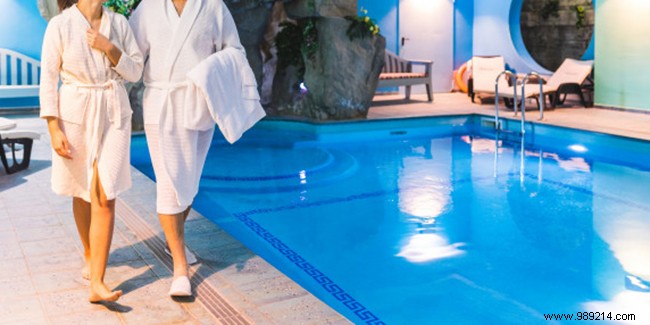
In France, the reimbursement of spa treatments represents 0.15% of the health insurance budget. Even if this ultimately represents small amounts in relation to the overall budget, in the context of a policy of budgetary savings, any item of expenditure must be analysed. Support is often incomplete. Reimbursement is only made on part of the total amount necessary to pay for a three-week spa treatment, the mandatory duration to open the right to reimbursement. The remainder can therefore represent a significant sum for people with modest incomes. Also in this file, we explain if these cures are really useful and effective, and if they are worth the expense.
In France, the year 2000 was a turning point for hydrotherapy insofar as the General Inspectorate of Social Affairs (Igas) published a report on this sector. He mentions a sector "in default, heterogeneous and poorly understood" whose "therapeutic interest is disputed". Although the activity of thermal establishments represents an important economic sector, the report underlines that 96% of treatment days are covered by health insurance, which constitutes a pronounced dependence on the social protection system. In addition, two therapeutic orientations (rheumatology and respiratory tract ) of the twelve recognized represented nearly 80% of total attendance. Finally, the report underlined that the hydrotherapy sector had not made the effort to follow the evolutions in terms of the evaluation of health products and therapeutic practices and that the publications concerning thermal cures proved to be not very credible. /P>
20 years later, the situation has changed. The French Association for Thermal Research (AFRETh) was notably created in 2004 to stimulate studies on the effects of hydrotherapy.
In 2008, an important study compared the impact of a three-week cure to that of taking an antidepressant, paroxetine, in patients suffering from Generalized Anxiety Disorder (GAD). Covering only 207 patients, a hundred for each cohort, the conclusions favorable to the cure had the honesty to recognize the limit of the scope of the study which had followed the patients for only two months. They also mentioned the scarcity of rigorous clinical trials in the field of hydrotherapy and the strength of regional economic considerations, which did not favor putting the study into perspective.
In 2009, a study involved 462 patients with osteoarthritis of the knee, all on the same drug treatment. It revealed an improvement in pain and mobility twice as high in spa guests as in non-spa guests, even after 9 months.
In 2011, a study called Maâthermes estimated an average weight loss of only 5% for spa treatments dedicated to overweight people.
On the health expenditure side, no study has yet been conducted to find out whether the use of spa treatments leads to a reduction in health expenditure.
But other studies on the effects of hydrotherapy have followed these and here is a summary of the benefits now recognized.
The High Authority for Health (Has) recognizes the analgesic effect of cures in cases of chronic low back pain and even goes so far as to recommend balneotherapy for people with rheumatoid arthritis. This is not a cure but a considerable improvement in the quality of life made possible by a significant reduction in pain. This results in a drop in medication intake of around 20 to 30% of anti-inflammatories or painkillers. Hand osteoarthritis is also well relieved by hot thermal water misting sessions.
Positive effects in dermatology are also recognized:people with psoriasis, atopic eczema, but also severe burns are the first people to expect relief from a spa treatment.
Beyond these few indications, you should know that the list of 12 therapeutic orientations covered by the Health Insurance remains unchanged:
Not all spa treatments are created equal. The thermal waters and muds differ depending on the location. Some are richer in sulphur, bicarbonate, sodium chloride,... so many minerals which have different actions on the body. This is why it is necessary to choose the thermal organism according to the pathology from which one suffers. The treatments applied are also different:thermal medicine is a specialty in its own right which is learned over two years of study. But it suffers from a lack of prestige:hydrotherapy attracts little young doctors. And general practitioners also lack precise information on the subject.
The therapeutic virtues of a spa treatment are not limited to the natural elements used. The personalized care resulting from spa treatments should be taken into account. For some patients, these cures are simply times during which they mobilize their bodies more. Very positive aspect when we know today the importance of movement in preventing the effects of aging and in reducing chronic pain. Spa treatments can also be an opportunity to relearn good food hygiene or the right ways to move, which can kick-start a positive daily life dynamic. A change of scenery, rest, attention from the staff... Spa treatments are undeniably a time that allows you to extricate yourself from daily hassles and worries and promotes self-confidence and rejuvenation .
These positive aspects favoring the therapeutic effects are difficult to measure scientifically, which explains why the benefits of hydrotherapy remain more to be assessed than those of a drug. In addition, study cohorts are often small, limiting the scope of studies. A study on hydrotherapy will painfully mobilize 400 patients when a pharmaceutical laboratory study easily mobilizes thousands.
Spa medicine is today a real natural and gentle medicine. Virtuous, it is based on the ecological use of natural resources and the adverse effects are almost non-existent. Patients who are particularly sensitive to the consequences of over-medicalization or to the uncomfortable effects of certain intrusive treatments may find positive alternatives in hydrotherapy.